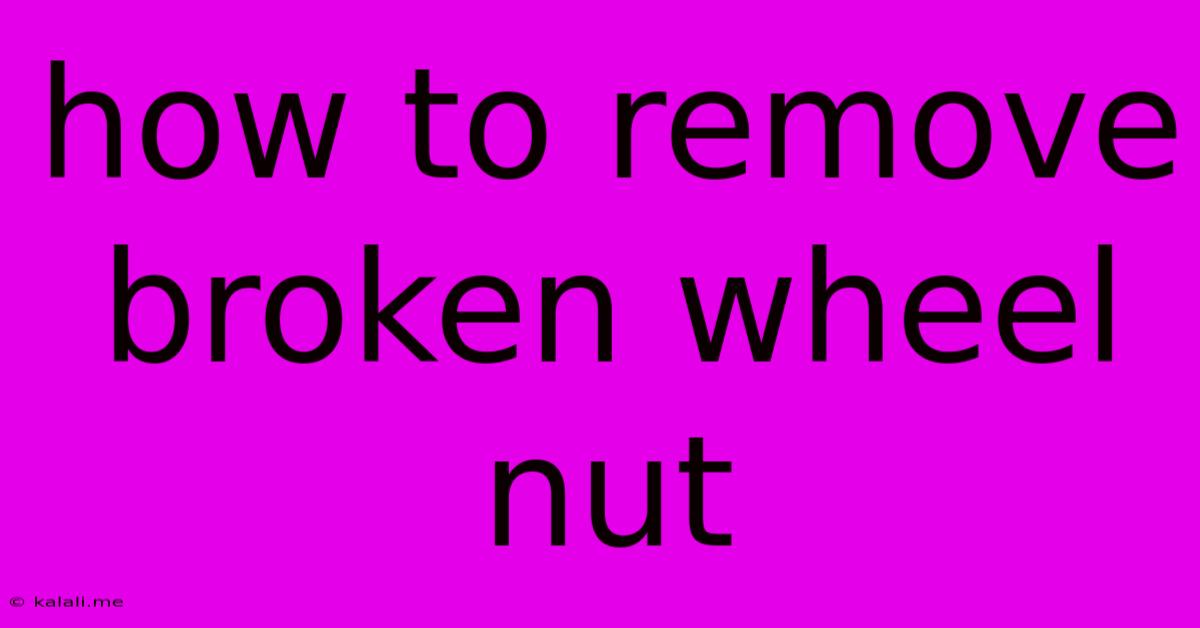How To Remove Broken Wheel Nut
Kalali
Jun 07, 2025 · 4 min read

Table of Contents
How to Remove a Stubborn or Broken Wheel Nut: A Comprehensive Guide
Removing a stubborn or broken wheel nut can be a frustrating experience, leaving you stranded and potentially unsafe. This comprehensive guide will walk you through various techniques to tackle this common automotive problem, from simple solutions to more advanced methods. Understanding the underlying causes can also help prevent this issue in the future.
This article covers the following aspects of removing a broken wheel nut:
- Understanding the Problem: Why Wheel Nuts Break
- Safety First: Essential Precautions
- Tools You'll Need
- Methods for Removing a Broken Wheel Nut
- Preventing Future Problems
Understanding the Problem: Why Wheel Nuts Break
Wheel nuts can break or seize due to several factors:
- Corrosion: Rust and corrosion are the most common culprits. Salt, moisture, and general wear and tear can cause the nut to seize to the wheel stud.
- Over-tightening: Excessive tightening during wheel changes can strip the nut or damage the stud.
- Impact damage: Curb impacts or other external forces can weaken the nut, making it prone to breakage.
- Improper lubrication: Lack of lubrication during assembly can lead to seizing.
Safety First: Essential Precautions
Before attempting any repair, prioritize safety:
- Park on a level surface: Ensure your vehicle is stable and secure.
- Engage the parking brake: This prevents accidental rolling.
- Use wheel chocks: Place chocks behind the wheels opposite the one you are working on.
- Wear safety glasses: Protect your eyes from flying debris.
- Work in a well-lit area: Good visibility is essential.
- Use appropriate tools: Avoid using damaged or inappropriate tools.
Tools You'll Need
Gather the following tools before you begin:
- Wheel wrench: A sturdy wheel wrench appropriate for your vehicle's lug nuts.
- Penetrating oil (like PB Blaster or WD-40): To help loosen rusted or seized nuts.
- Hammer: For striking tools.
- Impact wrench (optional but highly recommended): An impact wrench provides significantly more torque.
- Socket wrench and sockets (optional): If you prefer a more controlled approach than an impact wrench.
- Vice grips or pliers: For gripping broken nuts.
- Bolt extractor (optional): For extremely stubborn or broken nuts.
- Replacement wheel nuts: You'll likely need replacements once the broken nut is removed.
Methods for Removing a Broken Wheel Nut
Here's a step-by-step approach to removing a broken wheel nut, starting with the simplest techniques:
1. Penetrating Oil and Patience:
- Liberally apply penetrating oil to the broken nut. Allow it to soak for at least 15-30 minutes (or even longer). Reapply as needed.
- Attempt to loosen the nut with your wheel wrench. Use steady pressure; avoid jerking or applying excessive force.
2. Impact Wrench (Highly Recommended):
- If a standard wrench fails, an impact wrench is your best bet. Its high impact torque can often break free even severely rusted or damaged nuts.
3. Socket Wrench and Sockets:
- If you don't have an impact wrench, a socket wrench with the correct size socket provides more leverage than a standard wheel wrench. Apply steady, firm pressure.
4. Vice Grips or Pliers:
- For severely damaged nuts, try gripping the remaining portion of the nut with vice grips or pliers. Apply penetrating oil first. Use caution to avoid damaging the wheel stud.
5. Bolt Extractor (Last Resort):
- If all else fails, a bolt extractor is your last resort. These specialized tools drill into the broken nut, allowing you to extract the remaining pieces. This requires precision and careful handling.
6. Drilling and Removal (Advanced Technique):
- This is a method of last resort requiring experience and the right tools. You would drill a pilot hole and use an easy-out tool to remove the broken pieces. Improper use can severely damage the wheel stud.
Preventing Future Problems
- Regularly inspect your wheel nuts: Check for signs of corrosion or damage.
- Properly lubricate wheel nuts during installation: Use anti-seize compound on the wheel studs to prevent corrosion.
- Torque wheel nuts to the manufacturer's specifications: Over-tightening is a major cause of problems. Use a torque wrench for accurate tightening.
- Avoid driving over curbs or through potholes: These impacts can damage wheel nuts and studs.
By following these steps and prioritizing safety, you can successfully remove even the most stubborn broken wheel nut. Remember to replace the broken nut with a new one of the correct size and torque it properly to prevent future issues. If you are uncomfortable performing this repair yourself, seek professional assistance from a qualified mechanic.
Latest Posts
Latest Posts
-
Why Did Johan Want To Be With The Old Man
Jun 07, 2025
-
How To Connect Multiple Lights To One Switch
Jun 07, 2025
-
Why Wordpress Page Comes White After Migration
Jun 07, 2025
-
Hope You Had A Wonderful Christmas
Jun 07, 2025
-
Why Did Voldemort Want To Kill The Potters
Jun 07, 2025
Related Post
Thank you for visiting our website which covers about How To Remove Broken Wheel Nut . We hope the information provided has been useful to you. Feel free to contact us if you have any questions or need further assistance. See you next time and don't miss to bookmark.